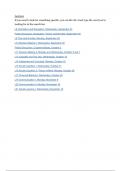Lectures
If you need to look for something specific, you can hit ctrl+f and type the word you’re
looking for in the search bar
L8 Orientation and Navigation, Wednesday, September 23
Friday Discussion, Navigation, Timing, and Number, September 25
L9 Time and Number, Monday, September 28
L10 Decision Making I, Wednesday, September 30
Friday Discussion, Cognitive Biases, October 2
L11 Decision Making II, Monday and Wednesday, October 5 and 7
L13 Causality and Tool Use, Wednesday, October 14
L14 Categories and Concepts, Monday, October 19
L15 Social Cognition I, Wednesday, October 21
L16 Social Cognition II: Theory of Mind, Monday, October 26
L17 Prosocial Behavior, Wednesday, October 28
L19 Communication I, Monday, November 9
L20 Communication II, Monday, November 16
L21 Social Learning I, Wednesday, November 18
,L8 Orientation and Navigation, Wednesday, September 23
Vocabulary
- Orientation is moving in the right direction or taking a bearing
- Navigation is getting to a destination
- large scale is homing and migration
- small scale is daily movement patterns (getting food/water, etc)
- Differs from orientation because navigation involves a destination
- Kinesis is non-directional movement in response to a stimulus
- Animals move randomly in the presence of the stimulus
- I.e. woodlice will start moving randomly in dryness and light- once they
get to a dark, damp environment, they’ll start moving
- Taxis (tax-iss, NOT taxi) is directional movement in response to a stimulus-
either towards or away from
- i.e male moths will fly 90 degrees to the wind trail until he picks up a
female scent, then flies against the wind until he finds her
- If you get in a taxi, you’re heading somewhere specific
- Nico Tinbergen was an ethologist, he conducted the pinecone experiment with
digger wasps
- Beacons are stimuli that mark the goal location. Like in minecraft
- Morris water maze- an animal is lowered into a pool of water with a platform in
the center. Sometimes the platform is underwater, and must be found relative to
a landmark, other times the platform is slightly above water providing a visual
beacon
- Path integration (also called dead reckoning) is mentalling tracking the combined
distance traveled in each direction on a journey
- Cognitive maps are a representation of space in the mind
- Homing is the ability to return to a nest or familiar site
- Like homing pigeons/carrier pigeons being used in WW1&2 and use them
to send messages
- Natal homing is getting back to the location where you were born (like sea
turtles)
, - Migration is seasonal, often annual, movement between habitats
- The hippocampus is a very specialized part of the brain that is crucial to
important roles and learning, especially memory
Notes
- Orientation can be thought of as an angle relative to a reference and could
include gravity, magnetic fields, sun of stars, heat or cold, wind, sound, etc
- Remember, orientation is directional by definition, barring kinesis
- Taxis is directional! Kinesis is random!
- Animals use landmarks to rely on navigation- a landmark would be something
like the Catalina mountains, which indicate you’re in Tucson
- Nico Tinbergen would find digger wasp nests, then move pinecones in a circle.
When the wasp took a “mental picture” and left, he moved the pinecones a few
feet and they could not find their nest when they returned. This was a beacon for
the digger wasps
- Many animals and children encode locations as absolute, not relative distances
- Beacons and landmarks are different- a beacon is a direct indicator of where
something is, where as landmarks indicate that you’re headed in the right
direction
- Species that cache food (get and hide food for later) tend to rely more on
landmarks
- Desert ants take super long paths around the desert, and after finding food, walk
directly back home. If you pick them up and move them, they will take the direct
path back, but since you moved them, they don't know where they are. They circle
and circle looking for their home
- There are different mechanisms for keeping track of distance. For example, bees
use optic flow, and mammals use the vestibular system (your inner ear). Ants use
a pedometer- literally a step counter.
- Ants on stilts… ants on stumps…
- It is debated whether animals have cognitive maps. Evidence that supports that
they have cognitive maps is that primates will take the shortest route to find
hidden food, and not follow the path in which they were hidden




